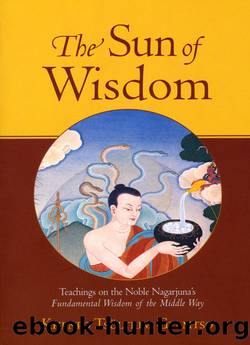The Sun of Wisdom by Khenpo Tsultrim Gyamtso

Author:Khenpo Tsultrim Gyamtso [Gyamtso, Khenpo Tsultrim]
Language: eng
Format: epub
Publisher: Shambhala
Published: 2003-03-11T04:00:00+00:00
16
An Examination of Bondage and Liberation
In the sutras, the Buddha taught:
Forms do not arise, and therefore they are neither bound nor liberated.
THE BUDDHA MADE SIMILAR STATEMENTS about sounds, smells, taste, bodily sensations, and so forth; and thus connecting this teaching with many other phenomena, he taught of the transcendence of bondage and liberation in a vast way.
That bondage and liberation appear to be real, that we think they are real, and that we seem to have further experiences that confirm our belief that they are real is still not enough to prove they are real, because all of this also happens in dreams. You may dream of being bound in iron chains and then being let out of them, or of being thrown into prison and then being set free. Your dream body was never born in the first place, however, and therefore there is nothing really there to be bound or liberated. Thus, dream bondage and liberation are mere appearances, not real in the slightest. The bondage and liberation that appear during the day are the same.
In Tibet, some Dharma practitioners were imprisoned for twenty years, but they say that it was a very good experienceâthat it helped their practice a lot. They were probably meditating on the transcendence of bondage and liberation!
In this chapter, Nagarjuna will prove the validity of this teaching with logical reasoning. The reason he composed this chapter was that there were people who thought, âThings do in fact have an inherent nature because we can perceive them to be bound in samsara or liberated in nirvana.â They used the existence of bondage and liberation as their proof of the existence of things. Thus, in order to help them give up their mistaken belief in true existence, Nagarjuna had to demonstrate to them why bondage and liberation do not exist in the genuine nature of reality.
Mipham Rinpocheâs commentary identifies two main sections in this chapter: first, a refutation of samsara and nirvana, and second, a refutation of bondage and liberation themselves. From the first section, the first verse of the entire chapter reads:
If one asks, âDo the aggregates wander?â
No, they do not, because permanent aggregates could not wander,
And impermanent aggregates could not wander either.
The same holds true for sentient beings.
This verse takes up the analysis in the following way: If samsara truly exists, there must be someone or something wandering around in it. If there is no one wandering in samsara, samsara cannot be real.
We can identify two possibilities for what the wanderer is: Either it is the set of five aggregates that constitutes the sentient being, or it is the sentient being who possesses these aggregates. Whichever of these two is wandering in samsara, it must be either permanent or impermanent if it truly exists. There is no other possibility.
First, let us examine the aggregates. It cannot be that permanent aggregates wander in samsara, because permanent aggregates would never change states or phases. They could not go from one life to another, even from one place to another, because they would be unchanging.
Download
This site does not store any files on its server. We only index and link to content provided by other sites. Please contact the content providers to delete copyright contents if any and email us, we'll remove relevant links or contents immediately.
Tools of Titans by Timothy Ferriss(7826)
Crystal Healing for Women by Mariah K. Lyons(7719)
The Witchcraft of Salem Village by Shirley Jackson(7044)
Inner Engineering: A Yogi's Guide to Joy by Sadhguru(6449)
The Four Agreements by Don Miguel Ruiz(6324)
The Power of Now: A Guide to Spiritual Enlightenment by Eckhart Tolle(5347)
Secrets of Antigravity Propulsion: Tesla, UFOs, and Classified Aerospace Technology by Ph.D. Paul A. Laviolette(5002)
The Wisdom of Sundays by Oprah Winfrey(4955)
Room 212 by Kate Stewart(4742)
Pale Blue Dot by Carl Sagan(4628)
Fear by Osho(4496)
The David Icke Guide to the Global Conspiracy (and how to end it) by David Icke(4387)
Rising Strong by Brene Brown(4195)
Animal Frequency by Melissa Alvarez(4161)
How to Change Your Mind by Michael Pollan(4115)
Sigil Witchery by Laura Tempest Zakroff(4034)
Real Magic by Dean Radin PhD(3929)
The Art of Happiness by The Dalai Lama(3851)
Man and His Symbols by Carl Gustav Jung(3847)
